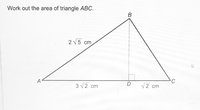Pythagoras with surds
- Thread starter Student31
- Start date
D
Deleted member 4993
Guest
Please show us what you have tried and exactly where you are stuck.
Please follow the rules of posting in this forum, as enunciated at:
Please share your work/thoughts about this assignment.
Hint: You know: AD = 3√2 & AB = 2√5 → BD = ?
Area = ?
pka
Elite Member
- Joined
- Jan 29, 2005
- Messages
- 11,988
In a right triangle the length of the altitude, a, to the hypotenuse forms a mean proportional the parts.
Thus a32=2a
Please show us what you have tried and exactly where you are stuck.
Please follow the rules of posting in this forum, as enunciated at:
Please share your work/thoughts about this assignment.
Hint: You know: AD = 3√2 & AB = 2√5 → BD = √2?
Area = ?
D
Deleted member 4993
Guest
You said: BD = √2?
Correct! That is the height of the triangle.
What is the base of this triangle?
Now use the known formula for area of a triangle.
What do you get?
Correct! That is the height of the triangle.
What is the base of this triangle?
Now use the known formula for area of a triangle.
What do you get?
Dr.Peterson
Elite Member
- Joined
- Nov 12, 2017
- Messages
- 16,814
But ABC is not a right triangle.In a right triangle the length of the altitude, a, to the hypotenuse forms a mean proportional the parts.
Thus a32=2a
A right
right angleHere is another hint.
What kind of angle is angle BDA?
What can you conclude therefore about triangle BDA?
Base is 3√2 so b x h = √2 x 3√2 = 4√2You said: BD = √2?
Correct! That is the height of the triangle.
What is the base of this triangle?
Now use the known formula for area of a triangle.
What do you get?
Then you have to divide by 2 which will be 2√2
pka
Elite Member
- Joined
- Jan 29, 2005
- Messages
- 11,988
Missed that! thanksBut ABC is not a right triangle.
Dr.Peterson
Elite Member
- Joined
- Nov 12, 2017
- Messages
- 16,814
The picture is very misleading, perhaps intentionally.
But on thinking about it more, it's also possible that they intended it to be a right triangle, but wrote [MATH]2\sqrt{5}[/MATH] where they meant [MATH]2\sqrt{6}[/MATH]. Of course, the proportions would still be off.
But on thinking about it more, it's also possible that they intended it to be a right triangle, but wrote [MATH]2\sqrt{5}[/MATH] where they meant [MATH]2\sqrt{6}[/MATH]. Of course, the proportions would still be off.
pka
Elite Member
- Joined
- Jan 29, 2005
- Messages
- 11,988
NO! Of course it is solvable. ΔABD is a right triangle.Does it make it unsolvable?
Therefore BD2=(25)2−(32)2=20−18=2. So BD=2
Area ΔABC=21(AC)(BD)
EXACTLY.A right
right angle
So you know the length of two sides of a right triangle. How can you compute the length of the third side?
And that side represents the what of the overall triangle?
EDIT: For some reason, students, when first introduced to surds, forget that they are just numbers that cannot be expressed exactly in decimal form (like most fractions). That does not mean that you cannot work with them like any other number. And a square root of a rational number when squared is just a rational number, which you have been working with since third grade.
Dr.Peterson
Elite Member
- Joined
- Nov 12, 2017
- Messages
- 16,814
Close. We want triangle ABC, whose base is not 3√2, but ... what?Base is 3√2 so b x h = √2 x 3√2 = 4√2
Then you have to divide by 2 which will be 2√2
Steven G
Elite Member
- Joined
- Dec 30, 2014
- Messages
- 14,591
You do realize that 3sqrt(2) = 3*sqrt(2)√2 x 3√2 = 4√2
Suppose 4sqrt(2) =sqrt(2)x3sqrt(2) = (sqrt(2)x3)xsqrt(2) by associative law. But only 4*sqrt(2) = 4sqrt(2). So then sqrt(2)x3 = 4 but that is not true. Please try again and as pointed out already use the correct base. Please post back.
pka
Elite Member
- Joined
- Jan 29, 2005
- Messages
- 11,988
That is exactly correct: AB=26 makes the mean proportional work.But on thinking about it more, it's also possible that they intended it to be a right triangle, but wrote [MATH]2\sqrt{5}[/MATH] where they meant [MATH]2\sqrt{6}[/MATH]. Of course, the proportions would still be off.
Then BD=6 does not seem too far off.
D
Deleted member 4993
Guest
ABC is the triangle whose area you need to FIND.Base is 3√2 so b x h = √2 x 3√2 = 4√2.........................................Incorrect
Then you have to divide by 2 which will be 2√2
Base of ABC = AC = ?
Dr.Peterson
Elite Member
- Joined
- Nov 12, 2017
- Messages
- 16,814
Of course, even then, you couldn't use the mean proportional to solve the problem without first showing that it is a right triangle, which I did by using ABD to find the altitude and check it against the mean proportional, so it becomes a little circular.That is exactly correct: AB=26 makes the mean proportional work.
Then BD=6 does not seem too far off.
Dr.Peterson
Elite Member
- Joined
- Nov 12, 2017
- Messages
- 16,814
When I said you were close, I missed the fact that you added where you said you were multiplying ...Base is 3√2 so b x h = √2 x 3√2 = 4√2
Then you have to divide by 2 which will be 2√2

